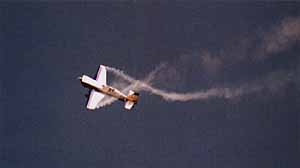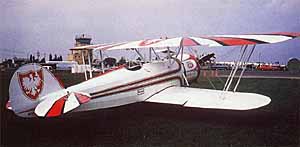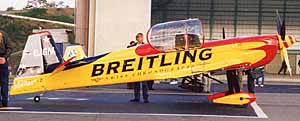
Gerald
Neel's large-scale Staudacher model with smoke on at the
Masters World Aerobatic Championships. |
Around
this time, one of the first German competition pilots, Gerhard
Fiesler (of later Fiesler Storch fame), was also the first to
develop inverted oil and fuel systems, leading to the real conquest
of inverted flight; Adolphe Pegoud's "stretched loop" of 1913
notwithstanding.
Doolittle
had beaten him to the Outside Loop by a few weeks, but in 1929
Gerhard put his own stamp on the future of aerobatics by inventing
the Rolling Circle thereby making life miserable for generations
of young aerobats to come, as they struggled to learn it. Gerhard
won the first World Championships in 1934, and remained active
in aerobatics well into the 1990s.
Gerhard's
career, along with those of Jimmy Doolittle, Chuck Yeager, and
Bob Hoover, proves that there are, indeed, a few old and bold
pilots.
Late in
the Roaring Twenties, the first military flight demonstration
teams were formed in response to repeated requests from larger
air show promoters for military participation, and the modern
concept of military formation aerobatics appeared.
In the
193Os. the US Army Air Corps Red Knights were the Thunderbirds
or Blue Angels of the day, thrilling crowds of air show spectators
with their Curtiss Hawk biplanes and inspiring young aerobatic
wannabes in bunches. The idea was to entice these dazzled youngisters
into the Army Air Corps or orher mililary flying schools. and
it worked brilliantly, providing Ameria with a well-trained
head start on the thousands of combat pilots that would be needed
all too soon.
|

WACO
Taperwing was the most aerobatic biplane of the Golden Age.
|
The idea
continues to work at air shows all over the world: The US Navy
Blue Angels team was founded in 1946. and the USAF Thunderbirds
followed a few years later. Today, nearly every country with
even a rudimemary air force boasts a flight demonstration team
of some sort, and hundreds of shows flown each year-there are
even international competilions whcre the demo tcams compete
with each other!
The Cluban
Eight was invented as an ad lib at the 1936 All American Air
Race Meeting in Miami, Florida.
Len Povey
was a famous American barnstormcr who was almost as well-known
for his quick wit and promotional abilities as he was for his
considerable aerobatic skills. In the early '30s the Cuban military
brass were looking for someone to advise and train the new Cuban
Air Force, and Len quickly talked himself into the job.
|

The
Cap 232 is the latest in a long line of winning aerobatic
designs from the French firm of Avions Mudry. |
After he
hsd been down lhere for a while, it was decided that he should
take one of the fledgling air force's new Curtiss Hawk biplanes
to the show in Miami to compete for the Freddie Lund Trophy
as a conbination publicily and recruiting stunt.
While performing
for the trophy, he decided to do a triple Avalanche: three snaps
at the top of a loop. At the top of the loop. Len saw that he
was carrying way too much entry speed for the snap, so he rode
over the top; coming down the back side, he did a half-roll
and pulled inro another loop, again half-rolling on the back
side before pulling out.
The new
maneuver was a minor sensation, and when Povey was asked by
the assembled press just exactly what he had done, he offhandedly
remarked that it was merely a "Cuban eight."
Bigger,
better, faster, and stronger remained the rule of the day right
up to World War II, when things aeronautical really got bigger,
better, faster, and stronger. Aerobatics were once again a matter
of pure survival for a new generation of combat pilots, and
the fun was placed on hold.
After WWII,
the biggest, most prestigious international aerobatic event
in the world was the Lockheed Trophy, held annually in Britain.
This event was not much like the rigorous current FAI aerobatic
competitions. It was essentially a freestyle program, judged
a lot like modern four-minute Free, with artistic impression
counting far more than precision.
|